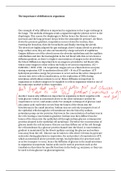Essay
The importance of diffusion in living organisms - A level biology essay (A*)
- Course
- Institution
- Book
A* marked biology essay (graded 24/25 by tutor and teacher), titled ' The importance of diffusion in organisms'. 6 Paragraphs with 1640 words. This essay was written earlier this year.
[Show more]




